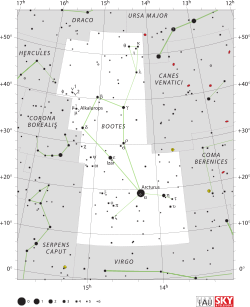Epsilon Boötis
| Observation data Epoch J2000 Equinox J2000 |
|
|---|---|
| Constellation | Boötes |
| Right ascension | 14h 44m 59.21746s |
| Declination | +27° 04′ 27.2099″ |
| Apparent magnitude (V) | 2.37 / 5.12 |
| Characteristics | |
| Spectral type | K0 II-III + A2 V |
| U−B color index | +0.73 |
| B−V color index | +0.97 |
| Astrometry | |
| Radial velocity (Rv) | -16.31 km/s |
| Proper motion (μ) |
RA: -50.95 mas/yr Dec.: +21.07 mas/yr |
| Parallax (π) | 16.10 ± 0.66mas |
| Distance | 203 ± 8 ly (62 ± 3 pc) |
| Details | |
| A | |
| Mass | 4.6 M☉ |
| Radius | 33 R☉ |
| Luminosity | 501 L☉ |
| Surface gravity (log g) | 2.2 cgs |
| Temperature | 4,550 K |
| Metallicity | –0.13 |
| Rotational velocity (v sin i) | 10.9 km/s |
| Age | 37.4 ± 4.2 Myr |
| B | |
| Rotational velocity (v sin i) | 123 km/s |
| Other designations | |
| Database references | |
| SIMBAD | data |
Epsilon Boötis (ε Boötis, abbreviated Epsilon Boo, ε Boo), also named Izar, is a binary star in the northern constellation of Boötes. The star system can be viewed with the unaided eye at night, but resolving the pair with a small telescope is challenging; an aperture of 76 mm (3.0 in) or greater is required.
ε Boötis (Latinised to Epsilon Boötis) is the star's Bayer designation.
It bore the traditional names Izar, Mirak and Mizar, and was named Pulcherrima by Otto Struve.Izar, Mirak and Mizar are derived from the Arabic إزار ’izār meaning 'veil' and المراق al-maraqq meaning 'the loins'; 'Pulcherrima' is Latin for 'loveliest'. In 2016, the International Astronomical Union organized a Working Group on Star Names (WGSN) to catalogue and standardize proper names for stars. The WGSN approved the name Izar for this star on 21 August 2016 and it is now so entered in the IAU Catalog of Star Names.
In the catalogue of stars in the Calendarium of Al Achsasi Al Mouakket, this star was designated Mintek al Aoua (منطقة العوّاء - minṭáqa al awwa), which was translated into Latin as Cingulum Latratoris, meaning belt of barker.
In Chinese, 梗河 (Gěng Hé), meaning Celestial Lance, refers to an asterism consisting of Epsilon Boötis, Sigma Boötis and Rho Boötis. Consequently, Epsilon Boötis itself is known as 梗河一 (Gěng Hé yī, English: the First Star of Celestial Lance.)
...
Wikipedia

